HISTORIC PEAR AND NUTTY PINE
/12 Comments/in Fruit, Gardening, Planning/by Lee ReichM’Lady’s Luscious Pear
Gardening provides so many avenues of interest down which to wander. The broad avenue of history, for example, which comes to mind as I checked up on the Lady Petre pear I made.
This pear’s most recent history traces back to last year when, after doing a grafting workshop with the Philadelphia Orchard Project at historic Bartram’s Garden in Philadelphia, I was offered a sprig from the Lady Petre pear tree there. I grow about two dozen varieties of pear, so the last thing I needed was another pear tree. But Lady Petre was special.
John Bartram is often considered “America’s first botanist.” In addition to collecting plants and sharing them with others, mostly in England, he sometimes received plants. Such as the pear seed from England’s Lady Petre, in 1735.
Quoting from the account published in John Loudon’s The Gardener’s Magazine of 1831, the seed was “planted by Mr. Bartram near one end of the dwelling-house, at the edge of a gravel walk, where It has never received any manure or rich earth . . . The tree has never been subject to blight, and has not once failed to bear In the last thirty years; some seasons producing 10 to 12 bushels of fine handsome fruit, which Is in good eating from the middle of September to Christmas. The fruit is always worth from three dollars to five dollars a bushel . . . It Is in the most perfect health, although near a century old.”
Almost a hundred years after that, Ulysses P. Hedrick wrote, in his 1921 tome, The Pears of New York, that “the tree still stands, somewhat stricken with its two centuries, but withal a noble specimen seemingly capable of breasting large blows of age for many years to come.” Alas, the Lady Petre tree finally succumbed to old age in the latter half of the 20th century — but not before someone had the foresight to clip of some branches to graft and make new trees.
As far as the fruit, Mr. Bartram wrote that “The Pear raised from her (Lady Petre’s) seed hath borne a number of the finest relished fruit. I think a better is not in the world.” More specifically, the fruit was described as having flesh that is “white, soft, juicy, melting, like a butter pear; delicious flavour, peculiar, very slightly musky, and vinous.”
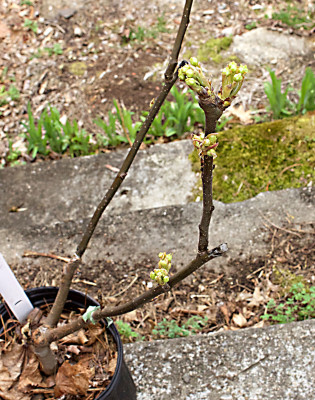
Flowers already forming on young grafted tree
And now I have a clone of that original plant and can look forward to tasting the fruit, the first variety of pear to have originated in America. The stated resistance to blight is a plus because blight — fireblight — is still a problem in pear orchards. (And fireblight has its own history: First noted in Highland Falls, NY, and the first recognized bacterial disease of plants.)
Mr. Bartram did state that “the tree was about twenty years old before It produced fruit, and narrowly escaped being cut down as barren.” Pear and apple trees grown from seed will often take 10 or 20 years before bearing fruit — and then the fruits they bear, more often than not, aren’t worth eating. Grafted trees bear sooner, and especially those grafted on dwarfing rootstocks. I made my Lady Petre pear tree by grafting the sprig I got onto a dwarfing rootstock so I’m hoping to be able to report back on the fruit within 5 years.
Not One, But Two, Grafts
My Lady Petre tree is special because not only is it the variety Lady Petre, and not only is it grafted on a dwarfing rootstock, but also because it’s an “interstem tree.”
Dwarfing rootstocks having the advantages of making trees that can be pruned and picked with feet on the ground. Not as obvious is their yielding more fruit per square foot of land because they harvest sunlight so efficiently. They also tend to bear at a younger age.
Many dwarfing rootstocks have restricted or brittle root systems. As a result, dwarf trees generally need first-class soil conditions as well as staking throughout their lifespans, which usually are shorter than full-size trees.
My interstem tree began life as a seedling I grew from a pear seed. Seedling trees are full-size and slow to begin bearing, but have resilient and sturdy roots. A few inches above ground level, I grafted a foot-long stem from a dwarfing rootstock. Atop that dwarfing interstem went the sprig of Lady Petre I had brought home from Philadelphia. That foot-long piece of stem from a dwarfing rootstock is all that’s needed to graft whatever goes above it.
Pears graft easily, so I was able to do both grafts at the same time last year, and have them take.
Many Pines are Nutty
Wandering down a different avenue, gardening can lead us into the future, or, at least, a vision of the future. Embodied, for example, in the 4 inch pot of soil sitting on my greenhouse bench. Poking up out of the soil are two small twigs. And I do mean small, each an inch or so high. Capping each is a small whorl of green needles.
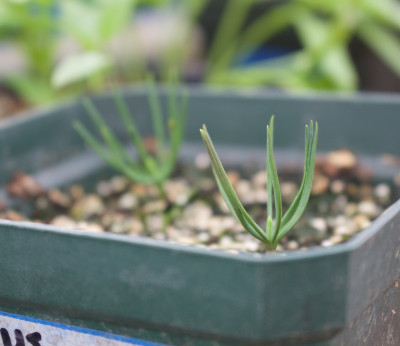
Limber pine seedlings
These two twiggy thingies are limber pine (Pinus flexilis) trees that I’m growing from seed. The common and botanical name relate to the plants flexibility; branches can be tied into knots. Looking into the future, these seedlings could grow to 60 feet in height and under good conditions — which would be drier, mountainous regions of western North America — could live over 1,000 years!
I’m growing limber pine for its seeds: pine nuts. All pines’ nuts are edible but only those with large nuts are worth bothering with. This one’s can be 1/3 by 1/2 inches large, although it will be many years before I’ll get to gather these tasty morsels from the two plants.
I’m guessing limber twig pine nuts and Lady Petre pears, both ready for harvest in early fall, will be a tasty combination.
FAILURES, SUCCESSES
/5 Comments/in Flowers, Gardening, Houseplants, Planning, Vegetables/by Lee ReichCan Anybody Tell Me How to Grow This?
Quotes about the rosy side of failure are not hard to find. ”Failure is the opportunity to begin again more intelligently,” wrote Henry Ford. John Dewey wrote that “Failure is instructive. The person who really thinks learns quite as much from his failures as from his successes.”
No, Mr. Dewey; in gardening, at least, failures are more instructive than successes. Put a seed into the ground and that seed has millions of years of evolution prompting it to grow. True, you can fail if starting with old seed, or soil so cold that the seed rots before it grows, or compacted clay soil that suffocates the seed. But generally, gardening is not that difficult. And generally, it’s hard to fail. So success is the norm, no matter — within reason — what you do.
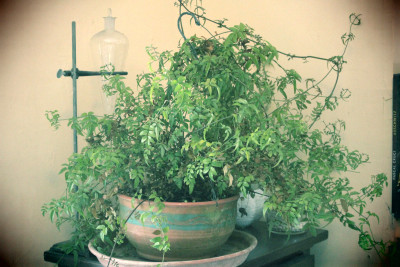
Jasmine — no flowers, again
For someone who pays particular attention to their gardening (and writes about it!), occasional failures are surely opportunities for learning and for success. Not so, for me! With my jasmine (Jasminium officinale) plant, at least.
I’ve grown this jasmine for many years. In its early years, the plant was a snowball of sweet-smelling white blossoms in late winter. Over the years, flower production has petered out, to the point where the plant coughs forths just a few blossoms here and there.
Many plants need a cold period to induce flower buds. Over the years, my jasmine has spent fall outdoors or in my cold basement (near a window) or in my cold greenhouse (minimum temperature 37°F).
Many plants need a dry period to coax on flower buds. Over the years, the soil in which my jasmine grows has been kept through fall just moist enough to keep the plant from wilting.
Some plants need a period of both cold and dryness for flowering. Check.
Besides all these treatments, I have tried various suggestions from others, including professionals who sell jasmine plants awash in bloom from their commercial greenhouses. No pruning after August. No artificial light in autumn. Generally good growing conditions all through summer. High phosphorus fertilizer. Check. Check. Check. Mmm-check. (I’ll admit I neglected the high phosphorus fertilizer. With ample compost, my potting soil has ample phosphorus, or so I assume.)
Now, in its thirteenth year here, jasmine has again not bloomed. I’ve learned nothing. Again, I’m threatening to walk it to the compost pile, counterbalanced by inklings of desire to give it one more try. (The phosphorus fertilizer, perhaps.)
My one possible consolation comes from reading a quote by George Bernard Shaw, “My reputation grows with every failure.”
Cardoon Futures
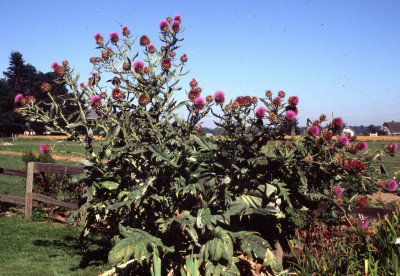
Cardoon I saw in Oregon
Enough self-flagellation. Let’s balance that out with a couple of successes, one the result of my doing, not driven by millions of years of evolution.
I’ve written previously about cardoon, a so-so vegetable but a fine ornamental. (True, many other people sing passionate gustatory praise for cardoon.) As a perennial, cardoon grows only leaves its first year from seed, which is fine if your eating it, because the leaf stalks are the edible part. The tall, spiny, olive green stalks, like a Mediterranean celery on steroids, also are dramatically ornamental in their own right.
The flowers, poised like cerulean bottlebrushes atop their tall — five feet high, or more — flower stalks are the real show, though. And, in that second year and beyond, you still get the whorls of giant leafstalks rising up from around the base of the plant.
Cardoon can’t tolerate winter cold below about 10 or 15°F, so it’s not winter cold-hardy here. Too much moisture around the crown of the plant might also help do it in during winter.
Last fall, after cold had settled into the ground, with about an inch depth of frost in the soil (towards the end of December) I cut back the top of the plant, then piled dry leaves over it. An overturned, 2-foot-diameter, plastic planter over the leaves kept them in place and added a bit more insulation and, also important, kept rain and snowfall off the plant. The drainage holes around the bottom (now the top) of the planter’s side allowed for some air movement within.
A week or so ago I tipped off the planter and untucked the leaves from around the plant. It was important to get to the plant before warmth got it growing, in which case the once-shaded, tender leaves would burn in the sunlight and be susceptible to frost. The leaves, just starting to emerge from the decapitated plant, looked healthy and ready to stretch out and grow after their winter’s rest. I look forward to the flowers.
Really Red Deer Tongue
Winter lettuce in the greenhouse is my other success. While many lettuces have begun to go to seed, especially those sown earlier in fall, the variety Really Red Deer Tongue just keeps making new leaves in spite of it’s having been sown in early September of last year. The leaves, as the names says, are red and, I suppose, the shape of a deer’s tongue. I don’t normally eat deer tongues, but these leaves taste good.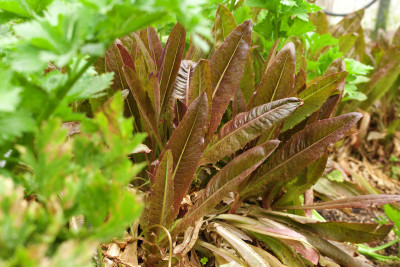
UPCOMING EVENTS
/1 Comment/in Gardening/by Lee ReichGRAFTING WORKSHOP, APRIL 9, 2016, Springtown Farmden, New Paltz, NY, www.leereich.com/workshops
LECTURE: LUSCIOUS LANDSCAPING, WITH FRUITS, APRIL 16, 2016, Hamilton College Arboretum, Clinton, NY
PRUNING WORKSHOP, MAY 6-8, 2016, Omega Institute, Rhinebeck, NY
DRIP IRRIGATION WORKSHOP, MAY 14, 2016, Phillies Bridge Farm Project, New Palts, NY, register at www.leereich.com/workshops
PLANT SALE, MAY 21, 2016, Springtown Farmden, New Paltz, NY, 9:30-11:59 am
And a final note to anyone who has subscribed to my blog: A gremliin may have entered the system and messed with the subscriptions. So if you’re not getting blog post notifications but want them, either re-subscribe or else unsubscribe and then re-subscribe.

